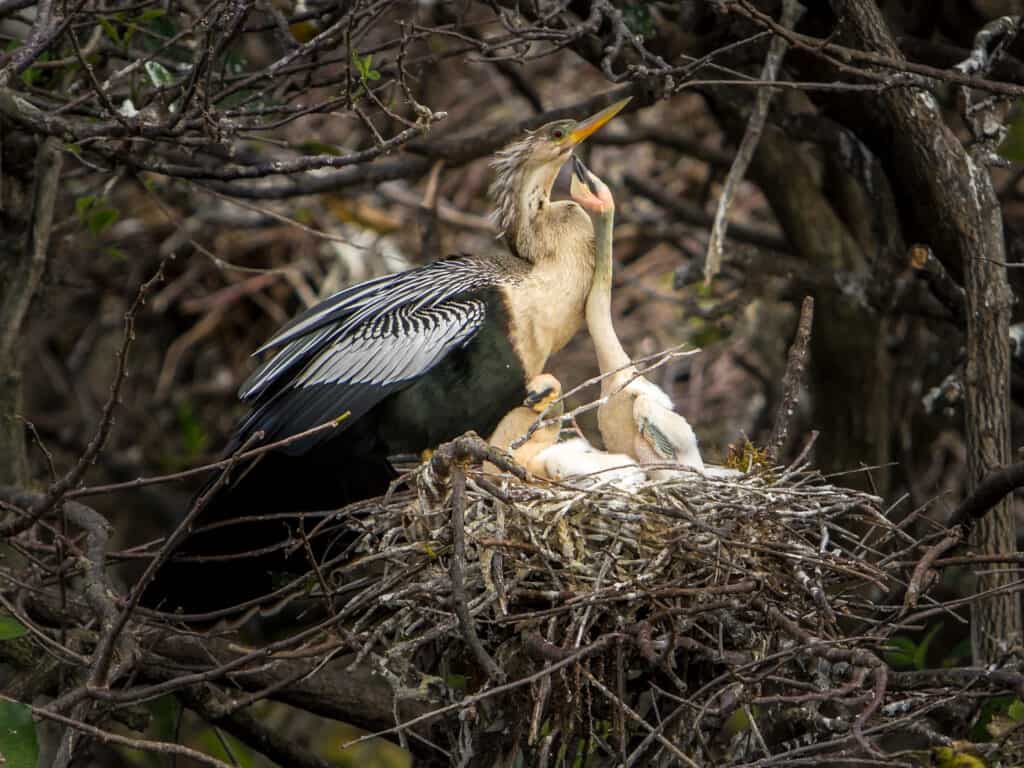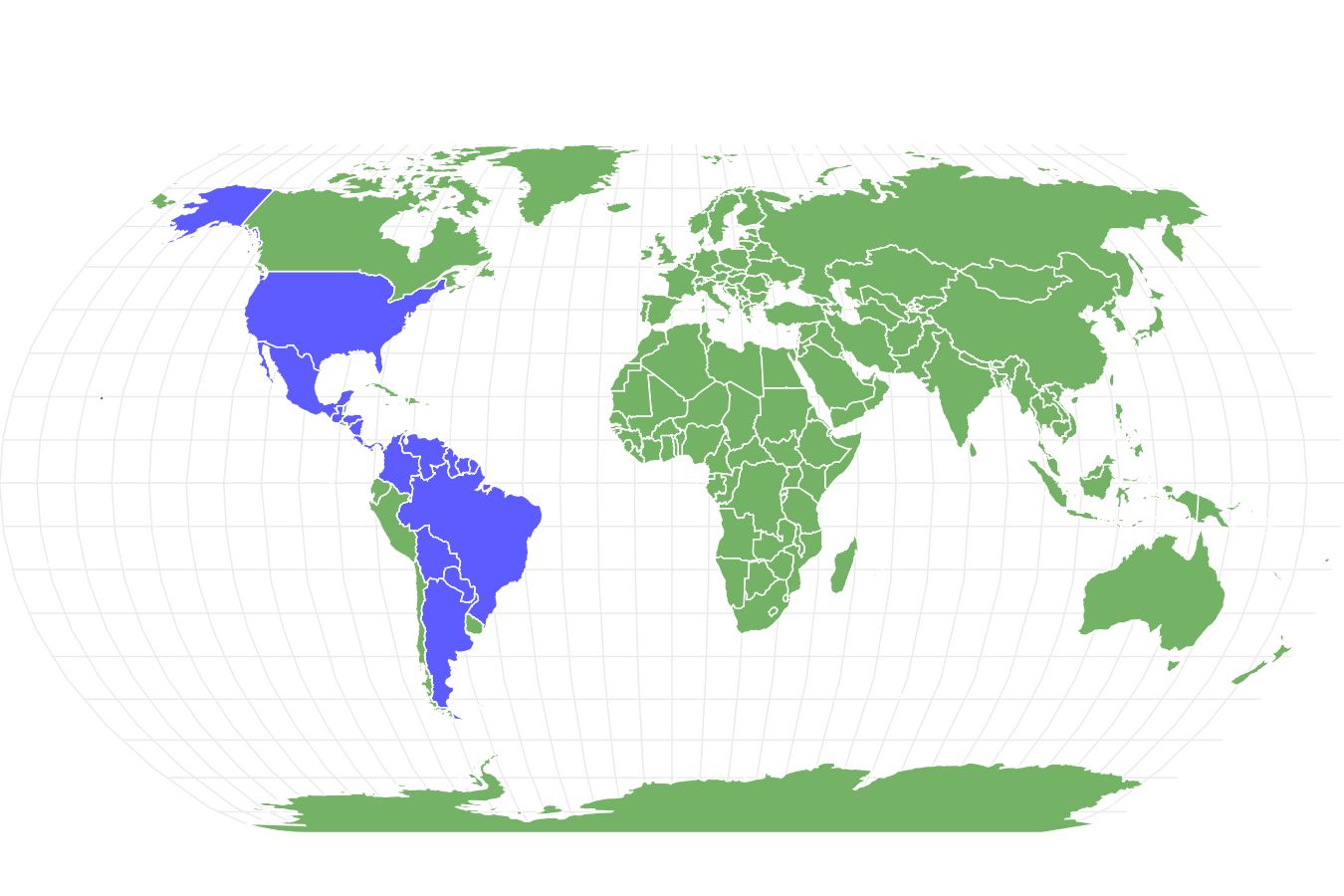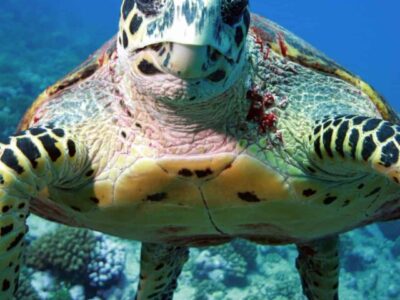Anhinga
Anhinga anhinga
Their name means snake bird
Advertisement
Anhinga Facts
- Prey
- fish, amphibians, crawfish, shrimp, crabs
- Main Prey
- fish
- Group Behavior
- Colonial Nesting
- Fun Fact
- Their name means snake bird
- Estimated Population Size
- 2,000,000
- Biggest Threat
- Loss of habitat
- Most Distinctive Feature
- Long S-shaped neck
- Distinctive Feature
- Sharp, yellow bill
- Other Name(s)
- Snakebird, American darter, or water turkey
- Wingspan
- 3.7 feet
- Incubation Period
- 26 to 30 days
- Age Of Fledgling
- 6 weeks
- Habitat
- Wetlands, marshes, and estuaries
- Predators
- Hawks, crocodiles, alligators
- Diet
- Carnivore
- Lifestyle
- Colony
- Pair
- Number Of Species
- 2
- Location
- North America, South America
- Average Clutch Size
- 5
- Nesting Location
- Trees near or above water
- Migratory
- 1
View all of the Anhinga images!
Anhinga Summary
“The anhinga’s name comes from the Tupi language and means ‘snake bird’”
The anhinga is a type of water bird known for its snake-hunting abilities. Some of its other names are snakebird, American darter, or water turkey—all of which refer to some aspect of its unique personality and appearance. They are often mistaken for cormorants due to their appearance. Because of their ability to thrive in a variety of areas, they’re often known to represent adaptability.
Anhinga Amazing Facts
- They don’t have waterproof feathers. This allows them to fully submerge themselves underwater to hunt!
- Not only are they expert swimmers and divers, but they’re also known to fly often, soaring above the trees thanks to thermals.
- They have a snakelike head and neck as well as a turkey-like fanned tail which are the source for many of their common names.
- The anhinga can dive as far as 60 feet below the surface, and they can stay submerged for up to a minute.
Where to Find Anhingas
The best place to find them is in South America. They can be found year-round in all of Brazil, French Guinea, Suriname, and Guyana, as well as occasionally in some of the surrounding countries such as Peru, Venezuela, Colombia, and Argentina. Further north, year-round populations can be found along the coastal areas of Mexico and the southeastern United States. In the United States, the best place to find an anhinga any time during the year is in Florida. You can, however, find them further north into Texas and coastal Georgia during their summer breeding months.
When you’re setting out to find one, it’s best to look around freshwater sources. Anhingas prefer shallow, slow-moving water, such as in marshes. Here, you can find them swimming or sunbathing. They are also seen flying occasionally.
Anhinga Nests
You’ll be surprised to learn that they are actually colony-based birds. They often nest in groups of pairs, which can sometimes include hundreds of individuals. Not only will they nest around other anhingas, but they’ve also been known to nest around other types of colonial birds, like waterfowl.
Males build their nests even before they have a mate. Typically, these nests are in trees that are close to the water, or even hanging over the water! The base of the nest is compact and made of sticks. However, they line it with softer materials, such as leaves, twigs, and cattails. If the nest has been used for a while, its exterior may have a white coating from their waste.
Anhinga Scientific Name
The anhinga’s scientific name is Anhinga anhinga. There are two subspecies: A. a. anhinga and A. a. leucogaster. Its class is Aves, as with many other birds, and it belongs to the family of Anhingidae.
Anhinga Size, Appearance, & Behavior

They often nest in groups of pairs, which can sometimes include hundreds of individuals.
©Bob Pool/Shutterstock.com
The anhinga is a rather large bird. They have a length of around 35 inches, and they weigh up to three pounds. Their wingspan is around 3.7 feet. A. a. anhinga is larger than A. a. leucogaster, though both subspecies have similar average sizes.
Anhingas have many notable features. First, they have a large bill that can be twice as long as their head. It comes to a sharp point that helps them to hunt, and it can easily be seen thanks to its yellow color. As water birds,they also have yellow webbed feet.
They display sexual dimorphism, which means males and females look different. Males are a glossy black with blue and green hues, much like a crow or raven. In certain areas, such as the base of their wings and tails, there is less of a green hue. The upper body and neck have white streaks they may have a purple hue. Females are similar except they have a chestnut color rather than black. Hatchlings’ first set of down is brown. It is replaced by a second white down before turning into brown feathers. As they reach maturity, they will develop the right colors depending on if they are male or female.
The anhinga is named for its long, snake-like neck. However, it has also garnered common names referring to its wide, fanned tail that resembles that of a turkey.
Migration Pattern and Timing
Migration is not common in anhingas. This is because a majority of the population are situated in year-round areas. However, during their breeding season, they may travel further north into the United States. This means that, rather than being found only around the coasts, they can be found deeper into Central Texas and along the southeastern coast in Georgia.
Anhinga Diet
The anhinga is different than most water birds. It has dense bones and no waterproof coating on its feathers. This allows them to fully submerge in water and dive for their prey.
What do anhingas eat?
Anhingas eat most of the common prey found in their choice of water sources. This includes snakes, crawfish, catfish, black bass, mullets, sunfish, crabs, shrimp, and tadpoles.
Anhinga Predators and Threats
The anhinga is considered to be a species of the least concern. However, their population was last assessed in 2016 and was determined to be declining however.
There are two main non-natural threats currently impacting the anhinga population in the western hemisphere. This includes loss of resources and pollution. Urbanization and overfishing have greatly reduced the food and space available to the anhinga, while pollution can cause illness in the ecosystems where they live.
There are also natural predators that pose a risk for anhingas.
What eats anhingas?
As large predatory birds, there are not many predators of the anhinga. For the young, they are at risk of other large birds, especially hawks. However, anhingas at all stages of life are preyed on by crocodiles and alligators.
While the parents are away hunting, hawks can easily swoop into the nest and steal away young anhingas. For those hanging over the water, alligators and crocodiles may be able to jump up and capture the young as prey. Adults are also at risk of being attacked by large reptiles. This most often occurs while they are submerged in the water and hunting. Due to their neutral buoyancy and dense bones, anhingas lack the ability to float for long on top of the water. As a result, attacks rarely occur on the surface.
Anhinga Reproduction, Babies, and Lifespan
Anhingas lay anywhere from 2 to 6 eggs per clutch. Their eggs are pointed on one end and have a greenish-blue hue, just like adult feathers. The eggs are longer than they are wide, with the largest of eggs measuring around 2 inches long and 1.5 inches wide.
The incubation period for anhingas is around 26 to 30 days. After this, the hatchlings emerge and are completely dependent on their parents. They being to grow their down and feathers, and, at three weeks, they are able to gain mobility and move around the inside and outside of the nest. They become fledglings at around six weeks old.
However, even after fledging, young anhingas won’t leave the nest for several more weeks. They reach sexual maturity at around two years of age, in which they will begin to construct their own nests and lay eggs.
Anhingas are monogamous and will mate for life. The oldest anhinga ever was 12 years old.
Anhinga Population
Although past assessments have shown the anhinga population to be of the least concern, there are no exact numbers of individuals. It is estimated that there are as many as two million individuals. However, due to the impact of the loss of habitat, their population is considered to be in decline.
Similar Birds to Anhingas
View all 194 animals that start with AAnhinga FAQs (Frequently Asked Questions)
Do anhingas migrate?
Not all populations of anhingas migrate. However, they can. During the breeding season, they can be found further north in the United States. After this time is over, however, they will return to their year-round residential areas.
How many eggs do anhingas lay?
Anhingas have average-sized clutches. On average, they lay anywhere from two to five eggs per clutch.
How fast does the anhinga fly?
Although there is no single speed for the anhinga, they are both average fliers and swimmers
What is the anhinga’s wingspan?
An adult anhinga has a medium- to large-sized wingspan. On average, their wingspans can grow to be up to 3.7 feet across.
When do anhingas leave the nest?
Anhingas fledge at around six weeks old. However, they won’t leave the nest for several more weeks. As a result, it is typical to see them leaving the nest anytime after six weeks.
Thank you for reading! Have some feedback for us? Contact the AZ Animals editorial team.
Sources
- IUCN / Accessed November 8, 2022

















